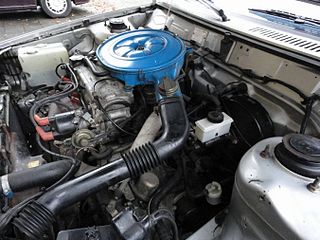
The F engine family from Mazda is a mid-sized inline-four piston engine with iron block, alloy head and belt-driven SOHC and DOHC configurations. Introduced in 1983 as the 1.6-litre F6, this engine was found in the Mazda B-Series truck and Mazda G platform models such as Mazda 626/Capella as well as many other models internationally including Mazda Bongo and Ford Freda clone, Mazda B-series based Ford Courier, Mazda 929 HC and the GD platform-based Ford Probe
The Mazda B-series is a small-sized, iron-block, inline four-cylinder engine with belt-driven SOHC and DOHC valvetrain ranging in displacement from 1.1 to 1.8 litres. It was used in a wide variety of applications, from front-wheel drive economy vehicles to the turbocharged full-time 4WD 323 GTX and rear-wheel drive Miata.

The Toyota JZ engine family is a series of inline-6 automobile engines produced by Toyota Motor Corporation. As a replacement for the M-series inline-6 engines, the JZ engines were 24-valve DOHC engines in 2.5- and 3.0-litre versions.

Honda's first production V6 was the C series; it was produced in displacements from 2.0 to 3.5 liters. The C engine was produced in various forms for over 20 years (1985–2005), having first been used in the KA series Legend model, and its British sister car the Rover 800-series.

The AJD is a family of V6 and V8 turbodiesel engines with a clean-sheet architecture and variable valve timing developed by Ford of Europe for its then-subsidiaries Jaguar and Land Rover, as well as for its partner PSA Group working under the Gemini joint development and production agreement. It is called the AJD-V6 in the Jaguar and Land Rover vehicles and the DT17/DT20 by Citroën and Peugeot. The engines share the same bore/stroke ratio, with the V6 version displacing 2.7 L (2,720 cc) and the V8 version displacing 3.6 L (3,630 cc). The V6 and the V8 were launched in 2004 and 2006 respectively. The V6 engine meets the Euro IV emissions standards. A DT20 3.0 L (2,993 cc) was added in 2009 and is based on the DT17 2.7 L (2,720 cc). The V6 is used across many vehicles, from the Citroën C5 and C6, to the Land Rover Discovery, Range Rover, multiple cars in the Jaguar range, and also the Ford Territory and next gen Ford Ranger.

The MA is a straight-4 SOHC 0.9 L, 1.0 L, or 1.2 L engine first introduced in 1982 by Nissan, intended primarily for the K10 series Micra/March model. It shares design similarities with the older E engine, with an 8-valve hemispherical cylinder head but differs in that it uses an aluminium cylinder block. Unusually, the specified ignition timing for the MA10 running on the specified 90 RON gasoline was 2 degrees after top dead centre, reflecting a very high flame speed in the compact combustion chambers.

The Mitsubishi 3G8 engine is a range of three-cylinder powerplant from Mitsubishi Motors, introduced in the fifth generation of their Mitsubishi Minica kei car. In common with other contemporary engines in the class, it could be specified with many advanced technologies despite its diminutive size, including multi-valve cylinder heads and double overhead camshafts. The top-of-the-line Dangan ZZ variant was also the first kei car to benefit from turbocharging. In 1987 Mitsubishi was the first manufacturer to supercharge a kei vehicle, and in 1989 became the world's first production car to feature five valves per cylinder, ahead of similar developments by Bugatti, Audi, Ferrari and Toyota.
The Toyota B engine family was a series of inline-four diesel engines.

The Toyota SZ engine family is a series of straight-4 piston engines with a forward-facing exhaust. Toyota Motor Manufacturing (UK) in Deeside produces SZ engines for the Yaris. All three types of the SZ engine are built in Tianjin FAW Toyota Engine Co., Ltd. (TFTE) Plant No. 1 in Xiqing District, Tianjin, China. The 2SZ-FE and 3SZ-FE variations are also manufactured by PT Astra Daihatsu Motor's Karawang Engine Plant in Indonesia.

The EA827 family of petrol engines was initially developed by Audi under Ludwig Kraus leadership and introduced in 1972 by the B1-series Audi 80, and went on to power many Volkswagen Group models, with later derivatives of the engine still in production into the 2010s. This is a very robust water-cooled engine configuration for four- up to eight- cylinders. In Brazil this engine was produced under the name Volkswagen AP AP.

The EN series engine is a four-cylinder, four-stroke engine used in kei cars sold by Subaru in Japan, succeeding the EK family of two-cylinder engines previously used in Subaru kei cars from 1958 to 1989. The EN family was introduced in 1989 and discontinued in 2012.

The Honda P engine is an inline three-cylinder gasoline engine first designed for use in Honda kei cars. The P engine was first used in the fourth generation Honda Life, as a successor to the Honda E07A engine. The P engine series was initially produced in only one displacement variant: 658 cc, either naturally aspirated or turbocharged. A turbocharged one-litre version, the P10A, has since been developed. The smaller version was discontinued in December 2013, when it was replaced by the new S07 series engine, but the P10A continues to be built in Thailand.

The Toyota NR engine family is a series of small inline-four piston engines designed and manufactured by Toyota, with capacities between 1.2 and 1.5 litres.

The Suzuki K engine family is a series of automobile engines from Suzuki, introduced in 1994. Displacements range from 0.7 L to 1.5 L. All engines have aluminium cylinder blocks with three or four cylinders in-line. Cylinder heads have two overhead camshafts, driven by chain, and four valves per cylinder. Fuel is gasoline/petrol, metered by multipoint fuel injection or direct injection. Some variants are turbocharged.












